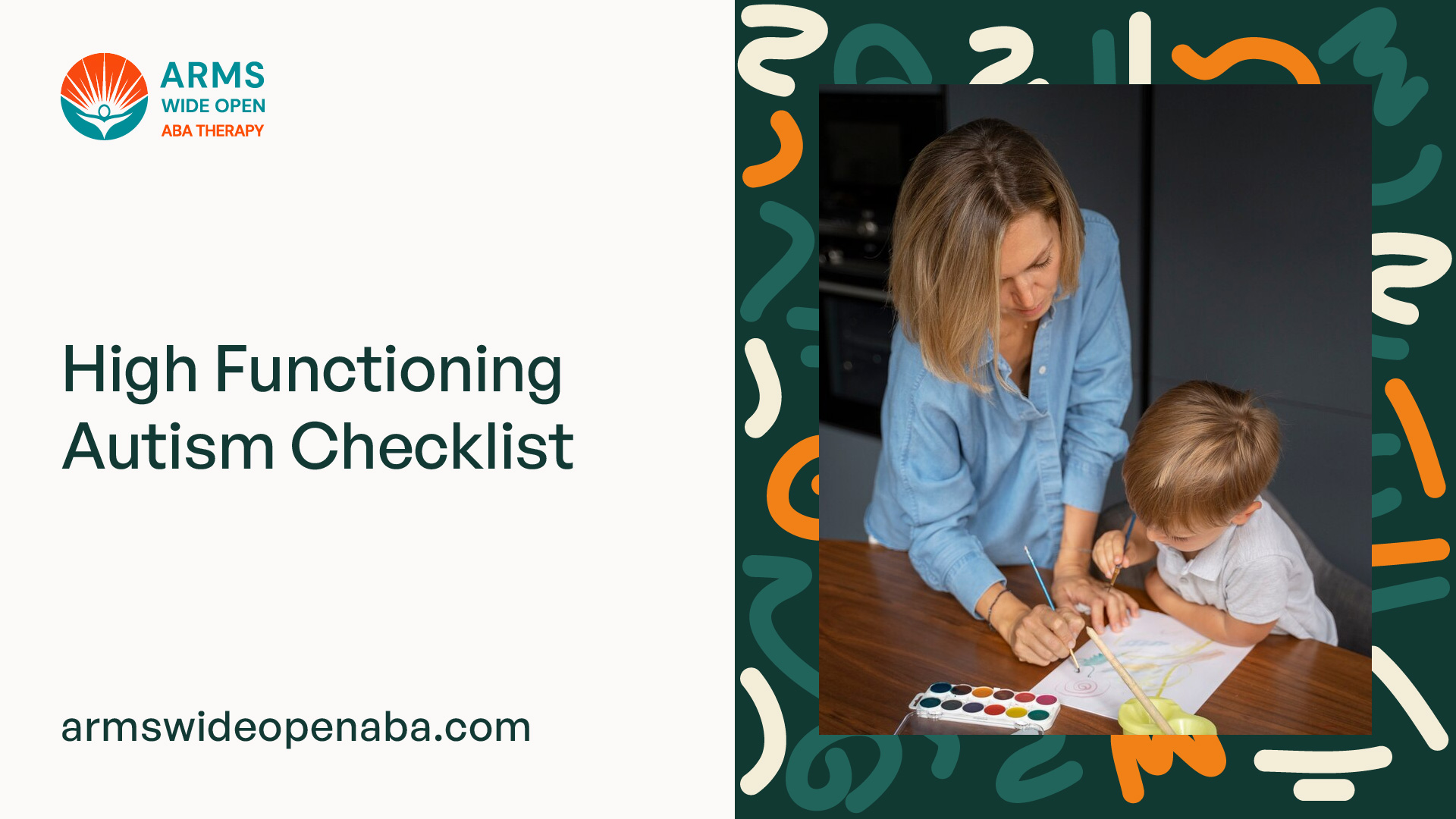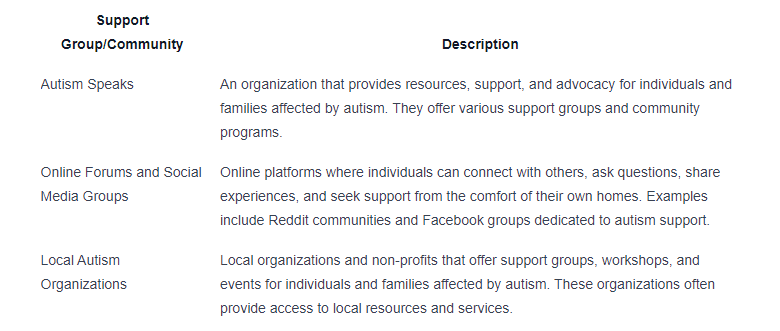High Functioning Autism Checklist
Unlock the high functioning autism checklist: A comprehensive guide to understanding and recognizing key traits for diagnosis.


Understanding High Functioning Autism
High functioning autism is a neurodevelopmental disorder that falls within the autism spectrum. It is characterized by challenges in social interactions, communication, and repetitive behaviors, but individuals with high functioning autism typically have average to above-average intelligence. In this section, we will explore what high functioning autism is and discuss its key characteristics.
What is High Functioning Autism?
High functioning autism refers to individuals who have autism but demonstrate relatively mild symptoms and higher levels of functioning compared to those with other forms of autism. While there is no official medical diagnosis of "high functioning autism," the term is often used to describe individuals who have autism and do not experience significant delays in language or cognitive abilities.
People with high functioning autism may have intact language skills and average or above-average intelligence. However, they still struggle with social interaction, communication, and may exhibit repetitive behaviors or intense interests. It's important to note that the term "high functioning autism" is not used in the latest edition of the Diagnostic and Statistical Manual of Mental Disorders (DSM-5), which instead uses the diagnosis of Autism Spectrum Disorder (ASD) with varying levels of support needs.
Characteristics of High Functioning Autism
Individuals with high functioning autism often display a range of characteristics that can manifest differently from person to person. Some common characteristics include:
- Social Challenges: Difficulties in social interactions and forming meaningful relationships. People with high functioning autism may struggle with understanding social cues, maintaining eye contact, and engaging in reciprocal conversation.
- Communication Difficulties: Challenges in the areas of verbal and nonverbal communication. They may have difficulty understanding and using gestures, facial expressions, and tone of voice. Some individuals may have a formal and pedantic speaking style, taking language very literally.
- Repetitive Behaviors and Interests: Engaging in repetitive movements or behaviors, such as hand-flapping or lining up objects. They may also develop intense and narrow interests, often focusing on a specific topic in great detail.
- Sensory Sensitivities: Heightened sensitivity to sensory stimuli, such as sounds, lights, textures, or smells. This can lead to sensory overload or avoidance of certain environments or situations.
It's important to remember that each individual with high functioning autism is unique, and the severity of these characteristics can vary from person to person. While these characteristics may present challenges, individuals with high functioning autism can also possess strengths such as exceptional memory, attention to detail, and a unique perspective on the world.
Understanding the definition and characteristics of high functioning autism lays the foundation for recognizing the importance of checklists in assessing and supporting individuals with this condition.
Importance of Checklists
Checklists play a crucial role in the diagnosis and understanding of high functioning autism. They serve as valuable tools for healthcare professionals, educators, and families in identifying and assessing the characteristics associated with this condition. By using checklists specifically designed for high functioning autism, individuals can gain a clearer understanding of their strengths, challenges, and unique needs.
Role of Checklists in Autism Diagnosis
Checklists are an essential component of the diagnostic process for high functioning autism. They provide a structured and systematic approach to evaluating the presence of specific behaviors and traits associated with this condition. Healthcare professionals, such as pediatricians, psychologists, and psychiatrists, often utilize checklists as part of their comprehensive assessment to aid in the diagnosis of high functioning autism.
These checklists are designed to capture a range of characteristics commonly observed in individuals with high functioning autism. By carefully observing and documenting behaviors related to social communication, repetitive behaviors, and sensory sensitivities, healthcare providers can gather valuable information to support an accurate diagnosis.
Benefits of Using Checklists
The use of checklists offers several benefits when it comes to understanding high functioning autism. Here are some key advantages:
- Standardization: Checklists provide a standardized approach to evaluating behaviors associated with high functioning autism. This ensures consistency across assessments and allows for more accurate comparisons over time.
- Efficiency: Checklists streamline the diagnostic process by providing a structured format to assess a wide range of behaviors and characteristics. This helps healthcare professionals to efficiently gather and organize information.
- Identification of Patterns: By systematically noting the presence or absence of specific behaviors, checklists help identify patterns and establish a comprehensive profile of an individual's strengths and challenges. This information can aid in developing targeted interventions and support strategies.
- Communication and Collaboration: Checklists facilitate effective communication and collaboration among healthcare providers, educators, and families. They serve as a common language to discuss and share information about an individual's specific needs and areas of development.
Using checklists does not provide a definitive diagnosis of high functioning autism on its own. They are part of a comprehensive assessment process that involves professional judgment and consideration of other factors. It is important to consult with a healthcare professional experienced in autism diagnosis and interpretation of checklist results.
By recognizing the role and benefits of checklists in understanding high functioning autism, individuals and their support networks can gain valuable insights into their unique characteristics and develop appropriate strategies to enhance their overall well-being and quality of life.

Components of a High Functioning Autism Checklist
A high functioning autism checklist is a valuable tool for assessing the presence of certain behaviors and characteristics associated with high functioning autism. It helps individuals, parents, and healthcare professionals identify potential signs of autism and determine if further evaluation is necessary. Here are the main components typically included in a high functioning autism checklist:
Social Communication Skills
Social communication skills encompass a range of abilities related to social interaction and communication. Individuals with high functioning autism may exhibit challenges in this area. The checklist may include items that assess:
- Verbal communication skills, such as the ability to initiate and maintain conversations, understand non-literal language, and use appropriate tone and volume.
- Non-verbal communication skills, including eye contact, facial expressions, body language, and gestures.
- Understanding and use of social cues, such as recognizing emotions, taking turns in conversation, and understanding sarcasm or jokes.
- Social interaction skills, such as making and maintaining friendships, understanding social norms, and engaging in reciprocal play.
Repetitive Behaviors and Interests
Repetitive behaviors and interests are common features of high functioning autism. The checklist may include items that evaluate:
- Repetitive movements or actions, like hand flapping, rocking, or spinning.
- Preoccupation with specific topics or interests, often with extensive knowledge in those areas.
- Adherence to routines and resistance to changes in schedules or rituals.
- Unusual sensory interests, such as intense fascination with certain textures, smells, or sounds.
Sensory Sensitivities
Many individuals with high functioning autism experience sensory sensitivities, where certain sensory stimuli can be overwhelming or cause discomfort. The checklist may include items related to:
- Sensory sensitivities to light, sound, touch, taste, or smell.
- Hypersensitivity or hyposensitivity to specific sensory inputs.
- Self-soothing behaviors like covering ears, avoiding certain textures, or seeking deep pressure.
When assessing these components, it is important to note that everyone with high functioning autism may have different strengths and challenges. The checklist provides a starting point for identifying potential areas of concern and can be used as a guide for further evaluation by healthcare professionals.
By using a high functioning autism checklist, individuals, parents, and healthcare providers can gain a better understanding of the behaviors and characteristics associated with high functioning autism. It is important to remember that a checklist is not a definitive diagnosis but can serve as a helpful tool in the assessment process.
Using the Checklist
Once you are familiar with the components of a high functioning autism checklist, it's important to know how to access the checklist and interpret the results.
How to Access a High Functioning Autism Checklist
Accessing a high functioning autism checklist can be done through various sources, including online platforms, healthcare providers, and autism organizations. Here are a few ways to obtain a high functioning autism checklist:
- Online resources: Many reputable autism organizations and websites offer downloadable checklists that you can access for free. These checklists are often available in PDF format and can be printed or filled out electronically.
- Healthcare providers: If you are seeking a professional diagnosis or evaluation, your healthcare provider or a specialist in autism spectrum disorders can provide you with a high functioning autism checklist. They may administer the checklist during an appointment or direct you to an online version.
- Autism organizations and support groups: Local autism organizations and support groups may offer resources and checklists specific to high functioning autism. They can provide guidance on accessing and utilizing the checklist effectively.
Remember, while checklists can be helpful in identifying potential signs of high functioning autism, they do not replace a formal diagnosis by a qualified healthcare professional. If you have concerns about yourself or a loved one, it's important to consult with a healthcare provider for a comprehensive evaluation.
How to Interpret the Results
Interpreting the results of a high functioning autism checklist requires careful consideration and professional judgment. Here are some key points to keep in mind:
- Scoring system: High functioning autism checklists often use a scoring system to assess the presence and severity of specific behaviors and characteristics associated with autism. Each item on the checklist may be assigned a point value, and the total score can help determine the likelihood of high functioning autism.
- Cut-off scores: Some checklists may have established cut-off scores that differentiate between individuals who may have high functioning autism and those who do not. These scores are based on research and clinical expertise. However, it's important to remember that a high score on a checklist does not provide a definitive diagnosis of high functioning autism.
- Professional evaluation: A high functioning autism checklist should be used as a tool to guide further evaluation and discussion with a healthcare professional. An experienced clinician or diagnostician can assess the checklist results along with other diagnostic criteria, observations, and interviews to make an accurate diagnosis.
It's essential to approach the results of a high functioning autism checklist with an open mind and seek professional guidance for a comprehensive evaluation. A healthcare provider or autism specialist can provide further insights, answer questions, and develop an appropriate plan of action based on the checklist results and individual circumstances.

Seeking Professional Help
When it comes to understanding high functioning autism, seeking professional help is essential for accurate assessment and diagnosis. Consulting with a healthcare provider who specializes in autism can provide valuable insights and guidance. This section will outline the importance of consulting with a healthcare provider and the next steps to take after using the high functioning autism checklist.
Consulting with a Healthcare Provider
Consulting with a healthcare provider, such as a pediatrician, psychiatrist, or psychologist, is an important step in the process of understanding high functioning autism. These professionals have the expertise and knowledge to evaluate the checklist results and provide a comprehensive assessment.
During the consultation, the healthcare provider will typically conduct a thorough evaluation that may involve interviews, observations, and additional assessments. They may also consider information from parents, teachers, and other individuals involved in the individual's life. This comprehensive evaluation helps in making an accurate diagnosis and identifying appropriate interventions and support.
It is important to remember that a high functioning autism checklist is not a diagnostic tool on its own. It serves as a screening tool that can indicate the presence of certain characteristics related to high functioning autism. A healthcare provider's expertise is crucial in interpreting the checklist results in the context of the individual's overall development and behavior.
Next Steps After Using the Checklist
After using the high functioning autism checklist and consulting with a healthcare provider, there are several possible next steps depending on the evaluation results. These may include:
- Further assessments: Based on the checklist results and the healthcare provider's evaluation, additional assessments may be recommended to gather more information about the individual's strengths, challenges, and specific needs. These assessments may include cognitive testing, language and communication assessments, and social-emotional evaluations.
- Development of an intervention plan: If a diagnosis of high functioning autism is confirmed, the healthcare provider can work with the individual and their family to develop an intervention plan tailored to their specific needs. This plan may involve various therapies, educational support, and strategies to enhance social communication skills, manage repetitive behaviors, and address sensory sensitivities.
- Accessing support services: The healthcare provider can provide guidance on accessing support services available in the community. This may include recommendations for support groups, therapy services, or specialized educational programs that can assist individuals with high functioning autism and their families.
- Continued monitoring and follow-up: High functioning autism is a lifelong condition, and regular monitoring and follow-up with the healthcare provider are essential. This allows for ongoing evaluation of progress, adjustment of interventions as needed, and addressing any new challenges or concerns that may arise.
Remember, the journey of understanding and supporting high functioning autism is a collaborative effort involving the individual, their family, and healthcare professionals. By seeking professional help and following through with the recommended next steps, individuals with high functioning autism can receive the necessary support and resources to thrive and reach their full potential.
Support and Resources
When it comes to high functioning autism, having access to support and resources can make a significant difference in the lives of individuals and families. Support groups and communities, along with additional resources, offer valuable assistance, understanding, and guidance.
Support Groups and Communities
Support groups and communities provide a safe space for individuals and families affected by high functioning autism to connect, share experiences, and offer support to one another. These groups often consist of individuals who have firsthand knowledge of the challenges and triumphs associated with autism. By participating in support groups and communities, individuals can gain a sense of belonging, find emotional support, and access valuable insights and resources.

Additional Resources for Families and Individuals with High Functioning Autism
Apart from support groups and communities, there are numerous additional resources available to support individuals and families affected by high functioning autism. These resources can provide information, strategies, and tools to navigate various aspects of life, including education, therapy, and daily living skills.

By utilizing support groups and communities, as well as additional resources, individuals and families affected by high functioning autism can access the support, information, and tools they need to navigate their unique journey. It's important to remember that each individual's experience with autism is unique, and finding the right support and resources can greatly contribute to their overall well-being and success.
Sources
https://www.thrivingwellnesscenter.com/blog/highfunctioningautismchecklist
https://www.myaspergerschild.com/2017/11/the-telltale-signs-of-high-functioning.html
https://www.thrivingwellnesscenter.com/blog/adultautismchecklist
Similar articles
We’re here to help you

Our team is here to assist you in this process. Contact us for any assistance.
it’s easy to apply
We Accept Most Insurances
Our in-network insurance partnerships make ABA therapy more accessible to families throughout our service areas.







Our Insurance Process
We'll request your insurance details to help us verify your plan's coverage for ABA therapy. Once we've received this information, we'll walk you through your benefits, including copayments, deductibles and out-of-pocket maximums, so you know what to expect in advance.
Our team will then handle the preauthorization and all the necessary paperwork.
.svg)





















.jpeg)


































.jpeg)




.jpeg)







.jpeg)











.jpeg)
















